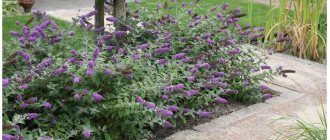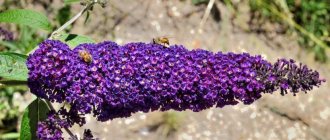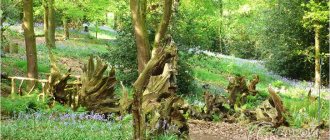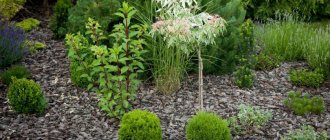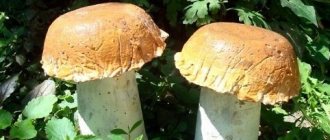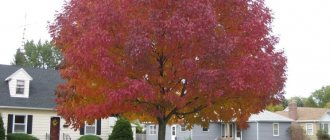Buddleia is a genus of ornamental perennial shrubs that, from a distance and at first glance, resemble lilacs: buddleia blooms with similar panicles.
However, up close, the differences are obvious: leaves of a different shape and texture, different bushes and not a lilac, but a hyacinth aroma, and the flowering time - from July to September, and in some varieties until October - give out a separate species in the plant, which is Carl Linnaeus, when compiling his “Systematics”, he named it in honor of Adam Buddle, a famous expert on mosses from Britain.
Description and useful properties
A spectacular evergreen or semi-deciduous shrub, Buddleia is a member of the Norichaceae family. In its homeland in Southern China it grows up to 3 meters in height, but in our climate it has more modest dimensions - no more than one and a half meters.
The compact buddleia shrub has good branching and fragrant flowers that attract bees, butterflies and other insects.
People also call it “butterfly bush”.
There are more than 100 species of this plant in the world. Sometimes there are trees up to 30 meters high.
The plant was brought to Europe in the 18th century. It was studied by the famous botanist and naturalist Carl Linnaeus.
But the French traveler and missionary Armand David discovered buddleia. The first botanically classified plant, Buddleia Davida, was named in his honor. Botanists noticed that a 5-meter-high crop in China and in England with its cooler climate grows up to 3 meters in height. They began to actively use it to decorate gardens.
Read about what plant is grown to create a hedge here.
Several new varieties have been bred for landscaping and decorating areas. Photos and descriptions of species will help you choose the most interesting specimens for your site. The rector of one of the English universities, Addam Buddle, made a great contribution to the selection. He was among the first to study the entire genus, its characteristics, and methods of reproduction.
Buddleia Davida is the most popular variety planted in Europe.
Russian flower growers were able to “tame” it and the shrub is perfect for growing in the Moscow region, Leningrad region and even in the Urals. Some species look very similar to garden hydrangea.
Buddleia blooms from June to October. Small five-petal flowers of the most incredible colors are collected in dense cylindrical inflorescences, completely hiding part of the shoot. On average, the length of the inflorescence is 20-30 centimeters, but under favorable conditions and planting of a certain variety it can reach one and a half meters.
Buddleia foliage
The color of the leaves and their size depend on the variety. There are specimens with small, about 7 centimeters, green leaves; in other species they are long with a gray tint or a white border along the edge of the lanceolate-shaped leaf blade, like Harlequin buddleia. The shrub is a frost-resistant plant, so this type of buddleia is popular in the Urals and other regions with cold winters.
Buddleia flowers, shoots and leaves have anti-inflammatory and analgesic properties.
The medicinal properties of the plant are used in the treatment of diseases of the liver and gastrointestinal tract, eye and skin diseases. The Chinese make infusions from buddleia flowers that help with conjunctivitis. And in cosmetology production, the plant is used to make products that protect the skin from ultraviolet rays.
The culture is unpretentious. In its homeland, it is often found on rocky, poor soils and grows well on sand and clay. Flowering ends with the formation of seeds, which, when ripened, randomly fall to the ground and give birth to new plants.
In America, there are special services in which the duties of employees include cutting off the flowering clusters so that the plant does not spread. And in Asian countries, goats are used to eat new shoots that appear. Considering that the seeds remain viable for several years, if the shoots are not removed, buddleia can very quickly fill everything around with itself.
Examples in landscape design
The variety of species and varieties allows the use of buddleia in the landscape design of large and small areas, public parks, gardens, and public gardens. A tall crop looks impressive in the corners of gardens, marking the boundaries of the territory. The low-growing budleya shrub is suitable for decorating a recreation area; it can be planted next to a gazebo or terrace.
This plant looks good as a border. With proper and timely pruning, you can create any shape - round, rectangular, and tall plantings will protect the area from prying eyes and dust from the road.
Trees or shrubs need to be planted at a considerable distance - at least 2-2.5 meters from each other.
Buddleia can be a luxurious accent to a flower bed. It should be planted in the center of the composition, and low-growing crops, for example, gatsania, aster, and sage, should become neighbors. You can experiment with several types of shrubs that differ in the shade of the flowers. Having planted them in one hole, experienced gardeners intertwine twigs and shoots, and during flowering, buddleia delights with its breathtaking multicolor.
Feature of the plant
Budleya is a tall bush. The plant can reach three meters in height. The leaves are approximately thirty centimeters long. They are located on the stem mainly in pairs. Flowers come in two varieties - panicles and spherical.
American varieties are characterized by a spherical inflorescence, while Asian varieties are characterized by an oval inflorescence. They are located at a very small distance from each other. The size of the buds is small. When open, they attract with their sweet honey aroma, and can have many shades.
Most often, gardeners grow purple buddleias. There are also fans of red, orange, yellow and pink bushes.
In nature, the following plant varieties exist:
- David;
- Budleya Vicha;
- Wilson;
- budleya the Beautiful;
- White-flowered;
- Alternate;
- budleya Snezhnaya;
- Japanese;
- Budleya Globose.
Oddly enough, white plants are extremely rare. Basically, they have dots of various shades on a white background.
The flowering period begins in the second half of summer and lasts until the end of autumn. In our country, these shrubs can be found not so often and they will mainly be the David variety. It gained its popularity due to its frost resistance.
When flowering is over, boxes containing seeds appear on the branches. One of the characteristic features of buddleia is that one inflorescence can simultaneously contain fruits, open and unopened buds.
This plant is not very fussy to care for. The bush tolerates winter frosts well. However, if there is no snow and the temperature drops below 20 degrees, then the above-ground part of the plant may freeze. But don’t worry, if this happens, then the budleya, due to its powerful root system, will produce new shoots and will again delight you with its lush, long flowering.
Types and varieties
In Russia, flower growers use different varieties and hybrids of the Buddleia Davida shrub. They are adapted to the climate of the Middle Zone, are unpretentious in care, and do not require constant attention. Buddleia "Royal Red" looks impressive next to hydrangea, but the bush does not tolerate severe frosts in winter. Therefore, planting and care in the Moscow region require mandatory shelter at the end of autumn. The variety is distinguished by intense colors of flower petals and a strong smell, so there are always a lot of butterflies around it.
Buddleia David "Empire Blue" with a photo has smaller panicles of flowers - no more than 30 centimeters, but the shade itself is very attractive. Purple blue or violet inflorescences look luxurious against the background of green foliage. The bush grows up to 2 meters. Suitable for creating borders.
No one will be indifferent to the flowering of Buddleia Davida “Flower Power”.
This is the product of the work of breeders who awarded the plant with the amazing ability to change the color of flowers.
At the peak of budding, the panicle on the shoot is covered with blue flowers, and when they bloom, they acquire an orange tint.
White-flowered buddleja albiflora
Fragrant flowers are formed on the shoots, arranged in a panicle up to 45 centimeters in length. Petals are purple with an orange center. It has a long flowering period and high frost resistance. Suitable for growing in climate zones with average winter temperatures down to -25 degrees.
Read about how to extend the life of fragile plants here.
David's buddleja davidii
The most numerous species with a variety of varietal forms. Grows on any soil, resistant to frost and various diseases. Buddleia Davida is the “parent” of many varieties. The colors of the “broom” are very different: white, lilac, pink, blue.
A characteristic feature that unites all shrubs of the buddleja davidii species is the yellow center inside the flower.
Commonly grown cultivars of the genus Buddleia Davida include:
- "Black Knight" is a 2-meter bush with violet-purple flowers;
- “Pink Delight” is a pink look with a very lush “panicle”;
- “Border Beauty” is a one and a half meter bush with red-pink, not very large inflorescences.
- "Nano Blue" - low-growing, suitable for creating borders along paths;
Buddleia "Nano Blue"
Buddleya "Royal Red"
Buddleia David "Ile de France"
Purple varieties are very popular among landscape designers and flower growers. They are distinguished by their massiveness and the length of the “panicle”. In addition, the flowers of the Buddleia Davida variety are planted very close to each other, so the blooming “cone” looks very impressive.
Alternate leaf buddleja alternifolia
It grows into a powerful bush up to 3.5-4 meters high. Buddleia alternate-leaved blooms at the end of May; until flowering, the bush ball looks greenish-silver due to the characteristic color of the leaves. The flowers are white, light purple or lilac.
Snowy buddleja nivea
In warm climates it is a massive bush up to 3 meters high; in less suitable conditions the size is not so large - 150-180 centimeters. The most popular variety of this buddleia is “White Proffusion”. Her panicle is white. In combination with other plants in the garden it looks very elegant and fresh. In the middle zone, "White" needs shelter for the winter.
Globe-shaped buddleja globosa
A distinctive feature of the variety is the spherical shape of the inflorescence. Yellow and orange flowers are collected in a ball, 3-5 centimeters in diameter, at the end of the shoot. Blooms from mid-May to late June. It is often compared to mimosa.
Japanese buddleja japonica
One of the oldest Japanese crops, used for landscaping since 1868. The inflorescences are not long (about 20 centimeters), the flowers of this buddleia are light purple in color. The “panicles” droop, the bush completely fades by the beginning of October.
Landing
In nurseries and flower shops you can buy buddleia seedlings of different types and varieties. Sellers offer specimens with a closed or open root system. Planting and care in open ground is easier when the root system is protected by a clod of earth. Typically, nurseries use fertilizing and fertilizers, so the plants are strong, and to plant buddleia, you just need to dig a hole and roll over the seedling along with the soil.
Planting and growing buddleia in the Moscow region is no more difficult than in other regions. This plant is unpretentious and grows in well-lit places and in partial shade. You can form a beautiful shape by trimming shoots.
Buddleia Davida is most suitable for growing in cold regions.
Planting and caring for the plant differs from warmer Russian regions in the timing of planting and the need to cover for the winter.
You can grow buddleia from seeds. They germinate well, and the sprout quickly increases in length and branches well. But budleya from seeds may not retain its maternal qualities, especially if different varieties grow nearby.
When to plant
It is best to plant the crop in spring or autumn. If a seedling is purchased at the end of summer, then it must be planted immediately before the first cold days and frosts arrive.
The buddleia plant needs time to take root in a new place, to “get over it”, and to feel the peculiarities of the climate.
It is not worth planting a seedling during a drought period. To form a powerful root system, the crop will need very abundant watering (several buckets per bush 2-3 times a week), and this will take a lot of time and effort. It is best to plant a bare root seedling in the spring. This way he will have enough time to settle down.
How to plant
If your site is not in a swamp or desert, then there is every chance of growing a luxurious bush. When choosing a place and thinking about how to plant a buddleia, pay attention to:
- soil quality - better if it is well drained;
- free space - David’s buddleia “Pink Dilight” needs about one and a half meters of space around, and low-growing varieties need about 2 meters;
- “neighbors” - only low crops that will not compete with the flowering bush can grow in the neighborhood.
After planting and watering, the ground around the root system needs to be mulched. This will keep the soil moist longer in the summer, and the roots will not freeze in the winter.
Growing and care
Agricultural technology for growing a powerful flowering bush is not complicated. Buddleia is unpretentious to grow. It is enough to choose the right place, regularly moisten the soil and prune the shoots on time. Buddleia planted in Siberia will require a little more attention. Planting and care in this region differ from warmer ones. The seedling should be planted in the first ten days of June, and in early September all work should be done to protect the buddleia bush from frost.
Trimming
This procedure is carried out annually to rejuvenate the buddleia bush and protect it from diseases and harmful insects.
Each type of pruning has its own characteristics:
- sanitary – frozen shoots and twigs are removed in the spring and dried shoots and twigs in the fall;
- rejuvenating - carried out in the spring in order to thin out the density of the bush, otherwise the splendor of flowering is reduced and the bush grows greatly.
There is no need to be afraid to trim buddleia branches. The bush recovers very quickly, and it is simply impossible to damage it by pruning.
Pruning the bush is the best way to stimulate flowering.
Reproduction
The easiest and fastest way to propagate a crop is by cuttings. Bushes of the second year of life are suitable for this. Lignified and semi-lignified buddleia branches are excellent as planting material.
In early spring, autumn or summer, branches 15-20 centimeters long are cut during pruning. They take root well in water and in moist soil; if desired, you can add a root formation stimulator to the water. The appearance of new leaves indicates that propagation was successful and the seedlings can be planted in a permanent place.
Growing from seeds in open ground is a longer process. Sowing seeds in the ground gives a germination rate of about 40 percent. Seed material requires stratification.
Before placing them in the ground, you need to soak them in hot water for several hours, and then keep them wrapped in a damp cloth for about a day.
To plant seeds, you need a loose, well-permeable substrate, a “greenhouse” made of film or a piece of glass, regular ventilation and moistening of the soil.
Watering and fertilizing
Buddleia bushes need regular and abundant watering. A large amount of leaf mass leads to strong evaporation of moisture, so its reserves must be constantly replenished. Water the plant only under the bush. Buddleia has delicate leaves, and when water gets on them, unsightly brown spots form. Watering is carried out in the evening or in the morning, while the sun is not yet too hot. Fertilizers are added several times a season along with watering. Organic and mineral compounds purchased in the store are also suitable. From September, feeding is stopped.
Pest diseases
The culture is resistant to diseases and pests. Buddleia is a shrub that is rarely attacked by spider mites and aphids. If you notice signs of their appearance, 2-3 applications of insecticides to the entire crown will help get rid of the pest invasion.
Multi-colored species grown on sandy soils can become infected with nematodes during dry periods. If the soil is heavy and does not allow moisture and air to pass through well, root rot develops. Its danger is that the grower does not immediately notice the signs of the disease, but it can completely destroy the buddleia bush.
To prevent the disease, watering is carried out with copper-containing preparations in spring and autumn.
After flowering
Most buddleia varieties bloom in September. But in October the weather is still warm, dry, and against the background of golden leaves on the trees in the garden, the green bush looks beautiful. Its appearance is spoiled only by red, wilted inflorescences. To increase the attractiveness of buddleia bushes, they are pruned. For species that finish blooming in June, pruning is carried out as soon as flowering has stopped.
Good to read: What dried flowers can be grown in the garden.
Wintering
Buddleia winters well, but flower growers still try to cover it so that in the spring they see not frozen branches and a diseased bush, but a beautiful plant ready for growth and flowering. At the end of September, all shoots are pruned, and lignified branches are sawed off with a sharp garden hacksaw. The cut areas are lubricated with garden varnish.
The height of the “hemp” must be at least 20 centimeters. It is covered with sawdust, covered with spruce branches and lutrasil.
A snowy winter will cover the buddleia with a snowdrift and it will overwinter well.
An article about crocuses - one of the most beautiful primroses.
Trimming
Caring for autumn lilac bushes does not imply constant grooming of the bush with pruning shears. But pruning in early spring only brings benefits - this way the bush retains its compact shape and flowering density. Before performing the procedure, be sure to treat the pruning shears and hacksaw with disinfectants and sharpen them. Perform pruning in compliance with the following rules:
- You can shorten the branches of the plant only after the end of frost - usually the beginning of March.
- The first in line for removal are diseased, frost-damaged, dead and weakened shoots.
- It is better to cut healthy stems of bushes to one level; to maintain their shape, the normal length is 60 cm.
Buddleia varieties that bloom in the summer season are cut short - old faded shoots are completely removed. It is not recommended to use the classic form of pruning shears - there is a tool for pruning and shaping shrubs with telescopic handles. When using such scissors, there is less risk of damaging those branches that need to be left intact to preserve their decorative appearance.
Reference!
The evergreen shrub variety “Colivillei” can bloom on branches left over from last year. This type of buddleia is not completely pruned - the branches on which there were inflorescences can be slightly shortened. In April, the longest branches are partially cut back so that the bush does not lose its attractiveness due to its height.
Growing buddleia at home
Buddleia “Blue Heaven”
The most hardy and easily adaptable to different conditions is Buddleia David. It can be grown not only in the garden in open ground, but also in tubs and flowerpots. To do this, choose low-growing varieties that, with proper pruning, can be formed into a tree.
To plant buddleia in a tub, use purchased soil mixed with turf garden substrate. Expanded clay drainage must be laid at the bottom of the flowerpot. A plant in a container looks great on terraces, next to gazebos, at the entrance to the yard, and the rules for caring for buddleia are the same as for growing it in the garden. The main thing is to trim the shoots in a timely manner to stimulate flowering.
Buddleia "Tutti Fruitti"
In the house, you need to choose a well-lit place near the window for a pot of buddleia, and when warm days come, move it to the balcony. And yet the bush truly reveals its beauty precisely in the open ground. So experiment and grow it in your garden plot rather than indoors.
Reproduction methods
Beginner gardeners first master the vegetative method of propagating buddleia. Planting material is obtained by dividing an adult bush or cuttings. Advanced gardeners and professionals grow new varieties from seeds.
Seeds
They buy seeds in specialized stores, rare varieties are ordered by mail, or found on the Internet. Hybrids and varieties of buddleia are offered by well-known agricultural companies:
- Gavrish;
- Search;
- Plasma Seeds;
- Aelita.
Sowing takes place from mid to late March. At the beginning of the month, the seed material is stratified - kept in the refrigerator for 2 weeks. For planting, take a plastic container with a lid. Fill it with a neutral substrate. Drainage is poured onto the bottom:
- fine expanded clay;
- eggshells;
- crushed nut shells.
Small seeds are sown superficially, sprinkled with a very thin layer of sand. The box is covered with glass (film). After 3 weeks, shoots appear. The transparent cover is removed when the seedlings become stronger. Later they are dumped into separate containers.
And first the seedlings are thinned out. Leave 1 plant per 3-4 cm. The room temperature is maintained at 22-28 °C. Two-week-old seedlings dive. Before transplanting into the ground, feed with humic fertilizers 2 times a month. With the arrival of stable heat (late May, June), the seedlings are transplanted into the ground.
